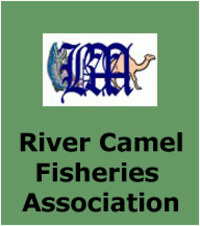Many thanks to The Butterwell Fishery for facilitating this camera's location and to the Westcountry Rivers Trust & River Camel Fisheries Association for capitally funding its installation. The Butterwell Fishery is situated in a scenic estate spanning 40 acres, just downstream of Nanstallon Village and approximately one mile upstream from the tidal reaches. It provides an excellent location for the River Camel webcam. The River Camel, known as "Dowr Kammel" in Cornish, meaning "crooked river," flows through Cornwall, England. Its source lies on the outskirts of Bodmin Moor, and its extensive catchment area covers a significant portion of North Cornwall. With a length of about 30 miles, it is the second longest river entirely within Cornwall, ultimately emptying into the eastern Celtic Sea between Stepper Point and Pentire Point. The river is influenced by tides upstream until Egloshayle and is renowned for activities such as sailing, birdwatching, and fishing. The name "Camel" originates from the Cornish language, referring to its meandering course.Historically, the river was divided into three distinct sections. The estuary up to Egloshayle was called "Heyl," the stretch between Egloshayle and Trecarne was known as the "River Allen," and the segment from its source to Trecarne retained the name "Camel." The River Camel originates on Hendraburnick Down, located on the fringes of Bodmin Moor, an area characterized by granite formations that comprise part of Cornwall's geological backbone. The river's path traverses sedimentary upper and middle Devonian rocks, primarily consisting of Upper Delabole Slates, Trevose Slates, and Polzeath Slates, which extend to the coastline, resulting in shallow acidic soils. In addition to sedimentary rocks, there are occurrences of igneous rocks at Brea Hill and Pentire Point, predominantly composed of pillow lavas. Stepper Point, situated at the mouth of the River Camel, is comprised of greenstone, as is The Rumps, a promontory on the northern side of Pentire Point facing Port Quin Bay.Historically, slate mining for construction purposes took place at various locations along the river, often involving the establishment of small quarries near the site of stone utilization. Presently, the only active quarry within the entire River Camel catchment area is located in Delabole. However, mining activities for lead and silver were previously conducted at Pentire Head and around Pinkson Creek, while a copper mine operated at Credis above Little Petherick. Further inland, the Camel and its tributaries border the St Austell mining lodes near Lanivet, where mining operations yielded tin, lead, silver, and copper. The area also saw extraction of iron ore in the form of hematite and associated manganese oxides. Although not a major producer, Mulberry Mine near Ruthernbridge produced approximately 1,300 tons of tin between 1859 and 1916. Historical records indicate that copper ore was transported from Padstow to Neath for smelting, and tin and copper ores were the primary commodities transported from Guineaport in 1830. Additionally, several small China Clay pits operated in the 19th century around Blisland and St Breward.The source of the River Camel lies at an elevation of 218 meters (715 ft) above sea level, with an average incline of 7 meters per kilometer. The upper stretches of the Camel and its tributaries primarily traverse moorland before transitioning into woodland and farmland, predominantly used for livestock. Consequently, approximately 64.8% of the catchment area consists of grassland, while 14.8% is arable land, and 12.9% is covered by woodland. The remaining 7.4% comprises urban areas, mountainous terrain, heath, bog, and inland waters.
The catchment area of the River Camel spans 413 square kilometers on the western side of Bodmin Moor, primarily characterized by Devonian slates and granite, with some shales and sandstones. Water volumes in the river are influenced by the Crowdy Marsh reservoir, water abstraction for public supply, and effluent from the sewage system around Bodmin. Data collected by the National River Flow Archive indicates that water flow in the River Camel during 2006 was significantly below average, corresponding to reduced rainfall, particularly between June and September. Similar trends of below-average annual flow were observed in 2013 and 2014, although there were instances of higher-than-average flow during winter. Given that the river runs for a considerable portion of its course in a steep-sided valley, sudden heavy downpours can cause rapid rises in water levels. While floods are not uncommon along the Camel, the flood event on July 16, 1847, was extraordinary. Triggered by a waterspout and deluge on Davidstow Moor, a wall of water swept away six bridges. However, Hellandbridge withstood the force of the flood, even though water flowed over the structure, leaving debris visible in nearby trees up to 20feet (6.1 m) above the normal river level. Presently, the tidal sections of the River Camel are susceptible to flood risk, particularly during spring tides following periods of heavy rainfall when the catchment area is already saturated. The Environment Agency has identified the Wadebridge area as a Critical Drainage Area (CDA), and the risk of flooding is expected to increase due to climate change. Consequently, all development within the CDA must account for flooding, including considerations for rainfall runoff.







